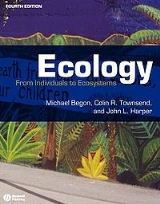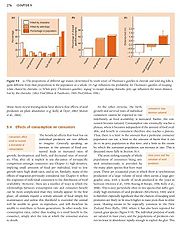
Ecology: From Individuals to Ecosystems
Encyclopedia
Ecology: From Individuals to Ecosystems is a 2006 higher education
textbook
on general ecology
written by Michael Begon, Colin R. Townsend and John L. Harper
. Published by Blackwell Publishing
, it is now in its fourth edition
. The first three editions were published by Blackwell Science under the title Ecology: Individuals, Populations and Communities. Since it first became available it has had a positive reception, and has long been one of the leading textbooks on ecology.
's School of Biosciences, Colin Townsend, from the Department of Zoology of New Zealand
's University of Otago
, and the University of Exeter
's John L. Harper
. The first edition was published in 1986. This was followed in 1990 with a second edition. The third edition became available in 1996. The most recent edition appeared in 2006 under the new subtitle
From Individuals to Ecosystems.
One of the book's authors, John L. Harper
, is now deceased. The fourth edition cover is an image of a mural on a Wellington
street created by Christopher Meech and a group of urban artists to generate thought about the topic of environmental degradation
. It reads "we did not inherit the earth from our ancestors, we borrowed it from our children."
1. Organisms in their environments: the evolutionary backdrop
2. Conditions
3. Resources
4. Life, death and life histories
5. Intraspecific competition
6. Dispersal, dormancy and metapopulations
7. Ecological applications at the level of organisms and single-species populations
Part 2. SPECIES INTERACTIONS
8. Interspecific competition
 9. The nature of predation
9. The nature of predation
10. The population dynamics of predation
11. Decomposers and detritivores
12. Parasitism and disease
13. Symbiosis and mutualism
14. Abundance
15. Ecological applications at the level of population interactions
Part 3. COMMUNITIES AND ECOSYSTEMS
16. The nature of the community
17. The flux of energy through ecosystems
18. The flux of matter through ecosystems
19. The influence of population interactions on community structure
20. Food webs
21. Patterns in species richness
22. Ecological applications at the level of communities and ecosystems
Higher education
Higher, post-secondary, tertiary, or third level education refers to the stage of learning that occurs at universities, academies, colleges, seminaries, and institutes of technology...
textbook
Textbook
A textbook or coursebook is a manual of instruction in any branch of study. Textbooks are produced according to the demands of educational institutions...
on general ecology
Ecology
Ecology is the scientific study of the relations that living organisms have with respect to each other and their natural environment. Variables of interest to ecologists include the composition, distribution, amount , number, and changing states of organisms within and among ecosystems...
written by Michael Begon, Colin R. Townsend and John L. Harper
John L. Harper
John Lander Harper CBE FRS was a British biologist, specializing in ecology and plant population biology.He was born in 1925 and educated at Lawrence Sheriff School, Rugby. He obtained his degree in Botany in and his MA and MPhil from Oxford...
. Published by Blackwell Publishing
Blackwell Publishing
Wiley-Blackwell is the international scientific, technical, medical, and scholarly publishing business of John Wiley & Sons. It was formed by the merger of John Wiley's Global Scientific, Technical, and Medical business with Blackwell Publishing, after Wiley took over Blackwell Publishing in...
, it is now in its fourth edition
Edition (book)
The bibliographical definition of an edition includes all copies of a book printed “from substantially the same setting of type,” including all minor typographical variants.- First edition :...
. The first three editions were published by Blackwell Science under the title Ecology: Individuals, Populations and Communities. Since it first became available it has had a positive reception, and has long been one of the leading textbooks on ecology.
Background and history
The book is written by Michael Begon of the University of LiverpoolUniversity of Liverpool
The University of Liverpool is a teaching and research university in the city of Liverpool, England. It is a member of the Russell Group of large research-intensive universities and the N8 Group for research collaboration. Founded in 1881 , it is also one of the six original "red brick" civic...
's School of Biosciences, Colin Townsend, from the Department of Zoology of New Zealand
New Zealand
New Zealand is an island country in the south-western Pacific Ocean comprising two main landmasses and numerous smaller islands. The country is situated some east of Australia across the Tasman Sea, and roughly south of the Pacific island nations of New Caledonia, Fiji, and Tonga...
's University of Otago
University of Otago
The University of Otago in Dunedin is New Zealand's oldest university with over 22,000 students enrolled during 2010.The university has New Zealand's highest average research quality and in New Zealand is second only to the University of Auckland in the number of A rated academic researchers it...
, and the University of Exeter
University of Exeter
The University of Exeter is a public university in South West England. It belongs to the 1994 Group, an association of 19 of the United Kingdom's smaller research-intensive universities....
's John L. Harper
John L. Harper
John Lander Harper CBE FRS was a British biologist, specializing in ecology and plant population biology.He was born in 1925 and educated at Lawrence Sheriff School, Rugby. He obtained his degree in Botany in and his MA and MPhil from Oxford...
. The first edition was published in 1986. This was followed in 1990 with a second edition. The third edition became available in 1996. The most recent edition appeared in 2006 under the new subtitle
Subtitle (titling)
In books and other works, a subtitle is an explanatory or alternate title. For example, Mary Shelley used a subtitle to give her most famous novel, Frankenstein; or, the Modern Prometheus, an alternate title to give a hint of the theme. In library cataloging the subtitle does not include an...
From Individuals to Ecosystems.
One of the book's authors, John L. Harper
John L. Harper
John Lander Harper CBE FRS was a British biologist, specializing in ecology and plant population biology.He was born in 1925 and educated at Lawrence Sheriff School, Rugby. He obtained his degree in Botany in and his MA and MPhil from Oxford...
, is now deceased. The fourth edition cover is an image of a mural on a Wellington
Wellington
Wellington is the capital city and third most populous urban area of New Zealand, although it is likely to have surpassed Christchurch due to the exodus following the Canterbury Earthquake. It is at the southwestern tip of the North Island, between Cook Strait and the Rimutaka Range...
street created by Christopher Meech and a group of urban artists to generate thought about the topic of environmental degradation
Environmental degradation
Environmental degradation is the deterioration of the environment through depletion of resources such as air, water and soil; the destruction of ecosystems and the extinction of wildlife...
. It reads "we did not inherit the earth from our ancestors, we borrowed it from our children."
Contents
Part 1. ORGANISMS1. Organisms in their environments: the evolutionary backdrop
2. Conditions
3. Resources
4. Life, death and life histories
5. Intraspecific competition
6. Dispersal, dormancy and metapopulations
7. Ecological applications at the level of organisms and single-species populations
Part 2. SPECIES INTERACTIONS
8. Interspecific competition

10. The population dynamics of predation
11. Decomposers and detritivores
12. Parasitism and disease
13. Symbiosis and mutualism
14. Abundance
15. Ecological applications at the level of population interactions
Part 3. COMMUNITIES AND ECOSYSTEMS
16. The nature of the community
17. The flux of energy through ecosystems
18. The flux of matter through ecosystems
19. The influence of population interactions on community structure
20. Food webs
21. Patterns in species richness
22. Ecological applications at the level of communities and ecosystems

